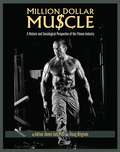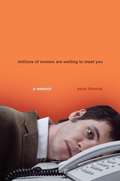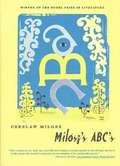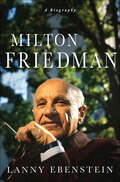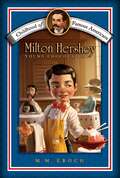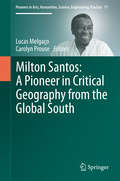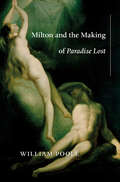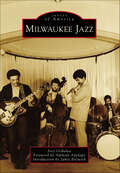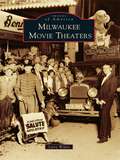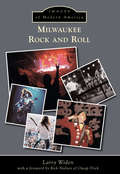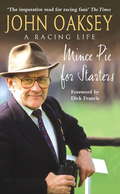- Table View
- List View
Milligan's Meaning of Life: An Autobiography of Sorts
by Spike MilliganSpike Milligan's legendary war memoirs are a hilarious and subversive first-hand account of the Second World War, as well as a fascinating portrait of the formative years of this towering comic genius, most famous as writer and star of The Goon Show. They have sold over 4.5 million copies.With his lightning-quick wit, unbridled creativity and his ear for the absurd, Milligan revolutionised British comedy, leaving a legacy of influence that stretches from Monty Python's Flying Circus to the work of self-confessed acolytes such as Eddie Izzard and Stephen Fry today.Throughout his life, Milligan wrote prolifically - scripts, poetry, fiction, as well as several volumes of memoir, in which he took an entirely idiosyncratic approach to the truth. In this ground-breaking work, Norma Farnes, his long-time manager, companion, counsellor and confidante, gathers together the loose threads, reads between the lines and draws on the full breadth of his writing to present his life in his own words: an autobiography - of sorts.From his childhood in India, through his early career as a jazz musician and sketch-show entertainer, his spells in North Africa and Italy with the Royal Artillery, to that fateful first broadcast of The Goon Show and beyond into the annals of comedy history, this is the autobiography Milligan never wrote.
Million Dollar Muscle: A Historic and Sociological Perspective of the Fitness Industry
by Adrian James Tan Doug Brignole"Million Dollar Muscle" is a unique anthology, co-authored by a "gym rat" with a Ph. D. in Sociology and a former competitive bodybuilder, fitness expert, and entrepreneur. The book offers a sociological perspective on the fitness industry, discussing how it is driven both by market forces and the culture of individual consumerism. Within a capitalist system the fitness industry is driven by the need to earn profits. From a small sub-culture it has grown into a multi-billion dollar industry. The market is now flooded with gyms, nutritional supplements, workout apparel, exercise equipment, and health and fitness magazines. With massive advertisements, and aided by the Hollywood culture and its emphasis on appearance, the fitness industry has grown to new dimensions, influencing individual choices and behaviors. "Million Dollar Muscle" discusses this evolution, along with what motivates people to make the choices they do. The material recognizes that these choices have important social implications. By combining an academic and theoretical approach with an "in the trenches" point of view, the book is able to bridge micro-macro aspects of the industry. It provides a comprehensive exploration of the individual choices regarding fitness, and why this is an important topic for sociological consideration. The following topics are discussed: - Market forces and the power these forces have to shape perceptions of reality;- The mechanics of capitalism and how these have changed traditional norms and customs which previously served practical purposes;- The danger of conforming to social norms;- Individual choices and how they are, in reality, driven by social forces "Million Dollar Muscle" is an unusual and intriguing text that successfully combines the thoughtful consideration of the social sciences with the "in-the-know" sensibility of an industry insider. Dr. Adrian James Tan, a Singapore-born American, is currently a faculty member at Southern Methodist University in the Sociology Department. He teaches courses in Introduction to Sociology, Marriage and Family, Sociological Theory, and Person vs. Society. Adrian obtained a bachelor's degree majoring in English and philosophy, and master's degrees in sociology and international affairs at Ohio University. Specializing in social psychology and ethnic identity, Adrian earned a Ph. D. in sociology at the University of North Texas, submitting his dissertation on the ethnic identity of Mexican-American children. Doug Brignole is a 37-year veteran of the fitness industry and a former Mr. California, Mr. America, and Mr. Universe winner. His competitive career spanned from the age of 16 until the age of 51. Doug is also a former gym owner, lecturer, author, fitness TV show host, and personal trainer. He writes for "Iron Man Magazine," appears on MuscleXL (an iPad app) where he gives video tips on biomechanics, and is currently working on a biomechanics book that explains the physics of exercise and how one can assess which exercises are productive and which ones pose a risk of injury. He has been certified by the American College of Sports Medicine and the American Council on Exercise.
Millionaire Moments: The Story of 'Who Wants to Be a Millionaire'
by Chris Tarrant'Which country is sandwiched between Ghana and Benin?'. Asked this question on £64,000, the very first contestant in ITV's hugely successful Who Wants to Be a Millionaire? opted to take the money. Some have since won a million on the show, whilst three have made absolutely nothing at all. The programme format has been sold to 120 countries - it is easily the most successful British light entertainment export of all time. Here, for the first time, presenter Chris Tarrant tells the story of the show's development from day one in September 1998 and describes his own thoughts about its enormous success. The book will include many of the multi-choice questions from the show, making it a truly interactive book for the quiz fan as well as a compulsive humour-interest story of big winners, big losers and some hysterical screamers.
Millionaire Women Next Door: The Many Journeys of Successful American Businesswomen
by Thomas J. StanleyMillionaire Women Next Door explores the meaning of wealth and the avenues that female entrepreneurs and businesspeople have traveled. The book examines their choices, natures, working styles, and lifestyles.
Millions of Women Are Waiting to Meet You: A Story of Life, Love and Internet Dating
by Sean ThomasSean Thomas was single, 37 and a bit desperate to meet the woman of his dreams when his magazine editor asked him to try Internet dating for a year. This is his painfully funny story of what happened next.
Milongas
by Edgardo CozarinskyWith an introduction by award-winning author Alberto Manguel, Milongas is Edgardo Cozarinsky's love letter to tango, and the diverse array of people who give it life.From tango&’s origins in the gritty bars of Buenos Aires, to milongas tucked away in the crypt of a London Church, a café in Kraków, or the quays of the Seine, Cozarinsky guides us through a shape-shifting dance&’s phantasmagoric past. In neighborhood dance halls vibrant and alive through the early hours of the morning, where young and old, foreign and native, novice and master come together to traverse borders, demographics, and social mores, &“it is impossible to distinguish the dance from the dancer.&” As conspiratorial as he is candid, Cozarinsky shares the secrets and culture of this timeless dance with us through glimmering anecdote, to celebrate its traditions, evolution, and the devotees who give it life.
Milosevic
by Dusko Doder Louise BransonWho is Slobodan Milosevic? Is he the next Saddam Hussein, the leader of a renegade nation who will continue to torment the United States for years to come? Or is he the next Moammar Qaddafi, an international outcast silenced for good by a resolute American bombing campaign? The war in Kosovo in the spring of 1999 introduced many Americans to the man the newspapers have called "the butcher of the Balkans," but few understand the crucial role he has played and continues to play in the most troubled part of Europe. Directly or indirectly, Milosevic has waged war and instigated brutal ethnic cleansing in Croatia, Bosnia, and Kosovo, and he was indicted for war crimes in May 1999. Milosevic's rise to power, from lowly Serbian apparatchik to president of Yugoslavia, is a tale of intrigue, cynical manipulation, and deceit whose full dimensions have never been presented to the American public. In this first full-length biography of the Yugoslav leader, veteran foreign correspondents Dusko Doder and Louise Branson paint a disturbing portrait of a cunning politician who has not shied from fomenting wars and double-crossing enemies and allies alike in his ruthless pursuit of power. Whereas most dictators encourage a cult of personality around themselves, Milosevic has been content to operate in the shadows, shunning publicity and allowing others to grab the limelight -- and then to take the heat when things go badly. Milosevic's secretive style, the authors show, emerged in response to a family history of depression (both of his parents committed suicide) and has served him well as he begins his second decade in power. Doder and Branson introduce us to the key figures behind Milosevic's rise: his wife, Mirjana Markovic, who is often described (with justification) as a Serbian Lady Macbeth, and the Balkan and American politicians who learned, too late, about the costs of underestimating Milosevic. They also reveal how the United States refused to take the necessary action in 1992 to remove Milosevic from power without bloodshed -- not realizing that he uses such moments of weakness as opportunities to lull his opponents into traps, thereby paving the way for a new consolidation of power. Now, in the wake of the victory in Kosovo, it remains to be seen whether America will learn this lesson or whether we will allow this deeply troubled man to continue to pose a threat to European peace and security as the twenty-first century dawns.
Milosz's ABC's: Memories, Dreams and Reflections from the Nobel Laureate
by Czeslaw Milosz Madeline G. LevineMemories, dreams and reflections from the Nobel Laureate The ABC book is a polish genre--a loose form related to a hypertext novel-composed of short, alphabetically arranged entries. In Milosz's conception, the ABC book becomes a sort of autobiographical reference book, combining entries concerning characters from his earlier work with references to some of his memory poems. He also writes of real, historical figures like Camus who were particularly influential during his formative years, and of broader topics such as "The City," "Unhappiness," and "Money. " Another fascinating entry in Milosz's bold opus, Milosz's ABCs is an engaging tribute to a brilliant mind. Czeslaw Milosz was awarded the 1978 Neustadt International Prize in Literature and the 1980 Nobel Prize in Literature. Since 1962 he has been a professor, now emeritus, of Slavic Languages and Literatures at the University of California, Berkeley. Among his recent publications are To Begin Where I Am,Striving Towards Being: The Letters of Czeslaw Milosz and Thomas Merton,and Road-side Dog. He lives in Berkeley, California, and Krakow, Poland. The ABC book is a Polish genre, a somewhat loose literary form composed of short, alphabetical entries. In Czeslaw Milosz's conception, the ABC book becomes a cross between autobiographical exposition and reference-book writing, combining citations of characters from his earlier prose works and poems with references to real, historical figures--such as Camus, Cezanne, Edward Hopper, Arthur Koestler, and Mark Edelman; the Polish writers Gombrowicz and Herbert; and the poets Baudelaire and Frost--who were particularly influential during his formative years. Throughout, the book investigates the times, towns, and terrains that have led this poet to think and write as he does. Milosz also looks to broader topics like "Unhappiness" and "Money" and "Churches. " Another outspoken and fascinating travelogue from Milosz's bold and crucial journey, Milosz's ABCs is an engaging tribute to a brilliant mind--the memories, dreams, and reflections of a literary master. "It is a source of wonderment and pleasure that at the age of 89, Czeslaw Milosz, arguably the greatest living poet, continues to publish exploratory works of self-definition and commemoration. Milosz's ABC's, expertly translated from the Polish by Madeline G. Levine, remakes the relatively recent Polish genre of the ABC book--a kind of subgenre of memoir--so that it becomes a flexible hybrid form, a probing and quirky reference book. "--Edward Hirsch,The New York Times Book Review. "It is a source of wonderment and pleasure that at the age of 89, Czeslaw Milosz, arguably the greatest living poet, continues to publish exploratory works of self-definition and commemoration. Milosz's ABC's, expertly translated from the Polish by Madeline G. Levine, remakes the relatively recent Polish genre of the ABC book--a kind of sub genre of memoir--so that it becomes a flexible hybrid form, a probing and quirky reference book ... In the end, Milosz's ABC's is a benedictory text, an alphabetical rescue operation, a testimonial to those who have suffered and gone before us, a hymn to the everlasting marvel and mystery of human existence. "--Edward Hirsch, The New York Times Book Review. "Milosz's greatness as a writer has something to do with his gift for going straight to the heart of a question--be it moral, artistic, political, autobiographical-- and answering it directly ... He is among those members of humankind who have had the ambiguous privilege of knowing and standing up to far more reality than the rest of us."--Seamus Heaney.
Milosz: A Biography
by Andrzej FranaszekAndrzej Franaszek’s award-winning biography of Czeslaw Milosz—winner of the Nobel Prize in Literature—recounts the poet’s odyssey through WWI, the Bolshevik revolution, the Nazi invasion of Poland, and the USSR’s postwar dominance of Eastern Europe. This edition contains a new introduction by the translators, along with maps and a chronology.
Milton Friedman and Economic Debate in the United States, 1932–1972, Volume 1 (Milton Friedman & Economic Debate in the United States)
by Edward NelsonMilton Friedman is widely recognized as one of the most influential economists of the twentieth century. Yet no previous study has distilled Friedman’s vast body of writings into an authoritative account of his research, his policy views, and his interventions in public debate. With this ambitious new work, Edward Nelson closes the gap: Milton Friedman and Economic Debate in the United States is the defining narrative on the famed economist, the first to grapple comprehensively with Friedman’s research output, economic framework, and legacy. This two-volume account provides a foundational introduction to Friedman’s role in several major economic debates that took place in the United States between 1932 and 1972. The first volume, which takes the story through 1960, covers the period in which Friedman began and developed his research on monetary policy. It traces Friedman’s thinking from his professional beginnings in the 1930s as a combative young microeconomist, to his wartime years on the staff of the US Treasury, and his emergence in the postwar period as a leading proponent of monetary policy. The second volume covers the years between 1960 and 1972— years that saw the publication of Friedman and Anna Schwartz’s Monetary History of the United States. The book also covers Friedman’s involvement in a number of debates in the 1960s and 1970s, on topics such as unemployment, inflation, consumer protection, and the environment. As a fellow monetary economist, Nelson writes from a unique vantage point, drawing on both his own expertise in monetary analysis and his deep familiarity with Friedman’s writings. Using extensive documentation, the book weaves together Friedman’s research contributions and his engagement in public debate, providing an unparalleled analysis of Friedman’s views on the economic developments of his day.
Milton Friedman: A Biography
by Lanny EbensteinThe first biography of one of the twentieth century's greatest economic thinkers, Milton Friedman.Born the son of immigrant parents, Milton Friedman went on to become a major figure during the resurgence of American conservatism. As an advisor to the Reagan administration and a widely read columnist, he played a vital role in shaping government policy and public opinion while he made headlines for his controversial views.Drawing on author Lanny Ebenstein's unprecedented access to personal archives and to Friedman himself, this is the first book to trace his life and development as an economic theorist. With a combination of intimate personal detail and fascinating exploration of economic theory, Milton Friedman: A Biography provides a revealing look at the man regarded by many as a hero of libertarianism and laissez-faire economics.
Milton Friedman: The Last Conservative
by Jennifer BurnsAn Economist Best Book of 2023 | One of The New York Times’ 33 Nonfiction Books to Read This Fall | Named a most anticipated fall book by the Chicago Tribune and Bloomberg | Finalist for the 2024 Hayek Book Prize“Wherever you sit on the political spectrum, there’s a lot to learn from this book. More than a biography of one controversial person, it’s an intellectual history of twentieth-century economic thought.” —Greg Rosalesky, NPR’s Planet Money The first full biography of America’s most renowned economist.Milton Friedman was, alongside John Maynard Keynes, the most influential economist of the twentieth century. His work was instrumental in the turn toward free markets that defined the 1980s, and his full-throated defenses of capitalism and freedom resonated with audiences around the world. It’s no wonder the last decades of the twentieth century have been called “the Age of Friedman”—or that analysts have sought to hold him responsible for both the rising prosperity and the social ills of recent times.In Milton Friedman, the first full biography to employ archival sources, the historian Jennifer Burns tells Friedman’s extraordinary story with the nuance it deserves. She provides lucid and lively context for his groundbreaking work on everything from why dentists earn less than doctors, to the vital importance of the money supply, to inflation and the limits of government planning and stimulus. She traces Friedman’s long-standing collaborations with women, including the economist Anna Schwartz; his complex relationships with powerful figures such as the Federal Reserve chairman Arthur Burns and the Treasury secretary George Shultz; and his direct interventions in policymaking at the highest levels. Most of all, Burns explores Friedman’s key role in creating a new economic vision and a modern American conservatism. The result is a revelatory biography of America’s first neoliberal—and perhaps its last great conservative.
Milton Hershey
by Jane SutcliffeNearly everyone knows the name Hershey. That's because Milton Hershey put his name on one of the most delicious foods in the world-chocolate. In the early 1900s, he invented a new recipe for milk chocolate. His five cent chocolate bars because a big business. But Milton Hershey wasn't always successful. The first few times he tried to sell candy, he failed. Still, Milton would not give up. He worked hard to invent delicious new recipes. He kept trying until his candy made him a wealthy man. Then he surprised everyone by give his money away.
Milton Hershey: Young Chocolatier (Childhood of Famous Americans)
by Meryl Henderson M. M. EbochDid you know that the man behind Hershey's chocolate used to work in an ice cream parlor? Or that he had to try over and over again to get his now-famous chocolate to taste as delicious as it does today? Milton Hershey's life wasn't always a bowl of chocolate Kisses. When he was in fourth grade, he even had to drop out of school and work to help his poor family make ends meet. Read all about how the man we know as the famous young chocolatier finally struck it rich -- in money, love, and chocolate!
Milton Santos: A Pioneer in Critical Geography from the Global South
by Lucas Melgaço Carolyn ProuseFor decades, Milton Santos (1926-2001) has been considered one of the most influential thinkers in Brazilian and Latin American social sciences and geography. Yet his writings, most of which have not been translated into English, are largely unknown to European and North American audiences. This book introduces English-speaking scholars to Professor Santos through critical engagement with his ideas and writings. The chapters presented here reveal the breadth and originality of his critical thought, as well as its ongoing importance to contemporary debates. The book features a biography of Santos and includes an annotated translation of one of his most-cited texts, The Return of the Territory, offered here for the first time in English. This text demonstrates how Santos's provocative insights continue to transform core concepts of political and human geography. The book also includes a number of short chapters written by scholars from Brazil, Spain and France. Through reflections on Santos's work, the various authors demonstrate the value and possibilities of extending the geographer's theories. They explore key geographical themes across political economy, rural studies, territorial planning, environmental crisis, digital networks, indigenous peoples, transportation and public health. This collection invites geographers from around the world to engage with this rich intellectual tradition from Brazil.
Milton and the English Revolution
by Christopher HillRemarkable reinterpretation of Milton and his poetry by one of the most famous historians of the 17th CenturyIn this remarkable book Christopher Hill used the learning gathered in a lifetime's study of seventeenth-century England to carry out a major reassessment of Milton as man, politician, poet, and religious thinker. The result is a Milton very different from most popular imagination: instead of a gloomy, sexless 'Puritan', we have a dashingly original thinker, branded with the contemporary reputation of a libertine. For Hill, Milton is an author who found his real stimulus less in the literature of classical and times and more in the political and religious radicalism of his own day. Hill demonstrates, with originality, learning and insight, how Milton's political and religious predicament is reflected in his classic poetry, particularly 'Paradise Lost' and 'Samson Agonistes'.
Milton and the Making of Paradise Lost
by William Poole&“An authoritative, and accessible, introduction to Milton&’s life and an engaging examination of the process of composing Paradise Lost&” (Choice). In early 1642 Milton promised English readers a work of literature so great that &“they should not willingly let it die.&” Twenty-five years later, the epic poem Paradise Lost appeared in print. In the interim, however, the poet had gone totally blind and had also become a controversial public figure―a man who had argued for the abolition of bishops, freedom of the press, the right to divorce, and the prerogative of a nation to depose and put to death an unsatisfactory ruler. These views had rendered him an outcast. William Poole devotes particular attention to Milton&’s personal life: his reading and education, his ambitions and anxieties, and the way he presented himself to the world. Although always a poet first, Milton was also a theologian and civil servant, vocations that informed the composition of his masterpiece. At the emotional center of this narrative is the astounding fact that Milton lost his sight in 1652. How did a blind man compose this intensely visual work? Poole opens up the world of Milton&’s masterpiece to modern readers, first by exploring Milton&’s life and intellectual preoccupations and then by explaining the poem itself―its structure, content, and meaning. &“Poole&’s book may well become what he shows Paradise Lost soon became: a classic.&” —Times Literary Supplement &“Smart and original . . . Demonstrates with astonishing exactitude how Milton&’s life and―most impressively of all―his reading enabled this epic.&” ―The Spectator &“This deeply learned and lucidly written book . . . makes this most ambitious of early modern poets accessible to his modern readers.&” ―Journal of British Studies
Milwaukee Jazz (Images of America)
by Joey GrihalvaMilwaukee's jazz scene has forever stood in the shadow of Chicago's illustrious institution, but it stands strong. Cream City has produced a wealth of talent, attracted top-notch transplants, and hosted legends like Duke Ellington, Dizzy Gillespie, Herbie Hancock, Billie Holiday, and Wynton Marsalis. From the heyday of the 1940s and 1950s to the renaissance of the 1970s, from the streets to the classrooms, from grand ballrooms to outdoor festivals, from swing to bebop, from smoky bars to dimly lit clubs like the Flame, Thelma's Back Door, and the Jazz Gallery, Milwaukee has been a hotbed of improvised music, providing a noteworthy contribution to the story of jazz in America.
Milwaukee Mafia: Mobsters In The Heartland (Images of America)
by Gavin SchmittMilwaukee is best known for its beer--and rightfully so. But in the days of Prohibition, the big alcohol suppliers were not Miller, Blatz, Schlitz, and Pabst. The Mafia had control, and it made its money by running alcohol as far away as Canada and Indiana, as well as with counterfeiting, the numbers racket, and two of the biggest heists in American history. From then on, the sky was the limit, as the Mafia indulged in extortion, protection rackets, and skimming from Las Vegas casinos. The Cream City had its crooked lawyers, corrupt cops, and even a mayor on the take. There was the blood of those who dared to stand in the syndicate's way, who were found dead in ditches or as victims of car bombs. The members of the Mafia included doctors, real estate men, restaurateurs, tavern owners, funeral directors, union presidents, and the most famous Milwaukee gangster of all, Frank Balistrieri. While now considered extinct, the Milwaukee Family was once a dominant force in the Midwest.
Milwaukee Movie Theaters: A Pictorial History Of Milwaukee's Movie Theaters (Images of America)
by Larry WidenPrior to World War II, there were 90 single-screen movie theaters in Milwaukee. By 1960, that number had been reduced by half. With the arrival of television for the home market, the golden age of the movie theater in Milwaukee was dead. Yet their ghosts continue to haunt the old neighborhoods. Churches, warehouses, stores, nightspots, and other businesses now occupy the former Tivoli, Paris, Roosevelt, and Savoy Buildings. Others are simply vacant hulks, decaying from the inside out. The Elite, Regent, Lincoln, and Warner are but a few of the many silent sentinels from the days when Milwaukee was in love with the movies.
Milwaukee Rock and Roll
by Larry Widen Rick Nielsen of Cheap TrickThe history of rock music in Milwaukee began at an age when some musicians played in a segregated part of the city. At the same time, a young singer named Buddy Holly kicked off a tour that ended with a plane crash in Iowa 11 days later. The following years brought the Beatles, Rolling Stones, and the rest of the British Invasion. In the late 1960s came acid rock, civil unrest, and Summerfest, a music festival that continues to this day. Milwaukee has had its moments in the spotlight: Bob Dylan left the stage after two songs in 1964, Bruce Springsteen's 1975 concert was delayed for hours while police searched for a bomb in the theater, hundreds of Black Sabbath fans rioted after a 1980 show, and the Plasmatics' Wendy O. Williams was beaten by police in 1981. And then there was the helicopter crash in which blues guitarist Stevie Ray Vaughn perished.
Milwaukee's Live Theater (Images of America)
by Jonathan WestMilwaukee's live theater scene is the sum of several exciting parts. For many, Milwaukee live theater means world-class productions done by resident actors at one of the nation's leading regional theaters. For others, it has been defined by the machinations of a respected experimental theater troupe that traveled throughout Europe in the 1980s and was once honored with an Obie Award. There was a time when Milwaukee live theater meant a big top arena where some of the biggest stars of American musical theater frolicked and played for local audiences. Audiences in Milwaukee have enjoyed the classics, new plays, and contemporary hits performed by never-say-die producers who boast personalities larger than the stages their companies play upon. The Milwaukee theater style is not fussy or overblown. It is informed by a thrilling past, buoyant future, unsurpassed community support, and unfailing devotion to solid midwestern work ethics channeled into artistic innovation. Simply put, Milwaukee's live theater scene is the best-kept artistic secret in the United States.
Min by på Sicilien
by Cristiano Parafioriti Bodil BerghI en serie noveller berättar Cristiano Parafioriti på ett levande sätt om sin uppväxt i en liten by på Sicilien. Ljuden från sparkade fotbollar och grälande kvinnor blandas med doften av mulåsnor och pinjeträd. Alla berättelserna genomsyras av genuin kärlek till familjen, vännerna, hembygden och även till hans katolska tro.
Mince Pie for Starters
by John OakseyJohn Oaksey has seen it all in racing, as a jockey, commentator and newspaper reporter. After a lifetime devoted to the sport he recalls the splendid characters, horses and races that have made horseracing the great passion of his life, a passion that he is so brilliantly able to convey to others. One of the most respected and loved people in the sport, partly due to his work with the Injured Jockeys' Fund, John Oaksey has a fund of fascinating and hilarious stories to tell. This book is not just a wonderful self-portrait, it is also a definitive account of racing since the war.
Mince Pie for Starters
by John OakseyJohn Oaksey has seen it all in racing, as a jockey, commentator and newspaper reporter. After a lifetime devoted to the sport he recalls the splendid characters, horses and races that have made horseracing the great passion of his life, a passion that he is so brilliantly able to convey to others. One of the most respected and loved people in the sport, partly due to his work with the Injured Jockeys' Fund, John Oaksey has a fund of fascinating and hilarious stories to tell. This book is not just a wonderful self-portrait, it is also a definitive account of racing since the war.

